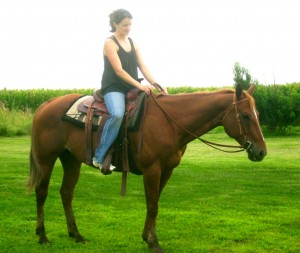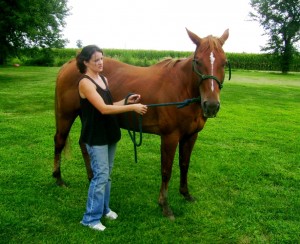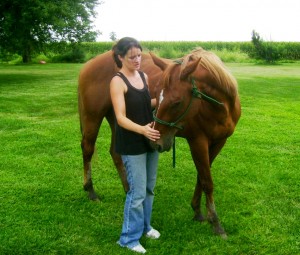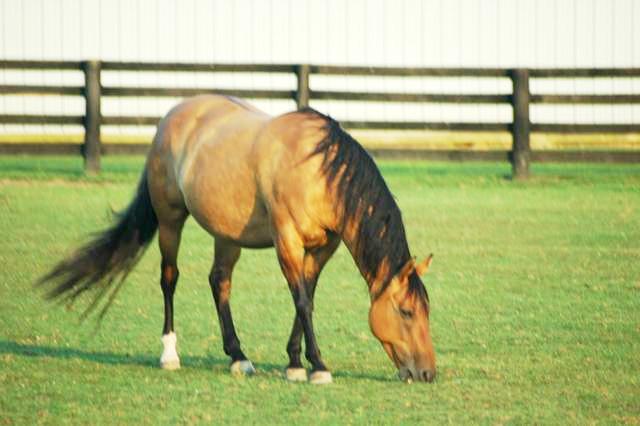 I started out to the barn last night with a goal in mind. With my sorrel mare, Daisy, there are a few improvements to be made. I would like her to be lighter, more responsive, have a better headset, and develop a strong topline. After asking the advice of a few horse friends, as well as reading up on some training articles, the conclusion I arrived at was that we needed to start with lateral flexion.
I started out to the barn last night with a goal in mind. With my sorrel mare, Daisy, there are a few improvements to be made. I would like her to be lighter, more responsive, have a better headset, and develop a strong topline. After asking the advice of a few horse friends, as well as reading up on some training articles, the conclusion I arrived at was that we needed to start with lateral flexion.
My mare Daisy was four years old when I bought her. She was gentle, halter broke, and loaded willingly in the trailer, and that was about all she knew. I put a little groundwork and long-lining training into her, and then basically just started riding her. In those first few lessons, I tied her head around to the stirrup with just one rein to introduce the bit to her and teach her to yield to rein pressure. She accepted that fine, so I left it with that and went straight to riding. But we never really worked on lateral or vertical flexion.
Looking into developing a headset, I read a couple different trainers’ opinions. Clinton Anderson swears by lateral flexion and says you can never repeat it too often. He says, “It’s like shaking hands with your horse and saying, Remember, now, when I pull, you give. It sets a tone.” He suggests doing it at the beginning and end of every ride. Julie Goodnight says she has had to retrain horses that were over-flexed and could not ride straight, they would flop their heads to the side at the slightest lift of a rein and only turn in tiny circles from the constant repetition of being asked to flex. So I have drawn my own conclusion that it’s is valuable but not to be overdone.
I decided to try it with Daisy, now ten years old, the idea being a gradual process of asking for a “give” and drop of her head, first on the ground, then from the saddle. Then gradually asking for a lower headset, and eventually performing it in motion, where she will move at a walk, trot, or lope with a lowered head and lighter feel. I am told this will help her collect, round her back, and help her be a lighter, more responsive horse. Beyond that, there are more advanced things I would like to learn about riding your horse in a frame and developing a better topline, but for now we are working on flexion. This is what we worked on yesterday:
I put Daisy in a rope halter and walked her out to a clear area without distractions or other horses nearby. You could longe your horse before working, if this helps get your horse focused on you and listening to your cues. Standing beside her shoulder, I used a direct pull on the lead rope to the side to ask for a slight bend in her neck. She moved her feet a little, thinking I was asking her to turn towards me, so I just moved with her and kept a constant steady pull on the lead rope. What I was watching for was for her to stop moving and tilt her head towards me, even the slightest bit, at which point I rewarded her by immediately releasing the rope and patting her and letting her stand straight again for a moment. Then we did it again, at which point she caught on very quickly, turning her face towards me, finding a place of submission where the rope doesn’t pull anymore and she is flexing her neck towards me. This is lateral flexion.
I did the same thing on the other side, asking for just a slight bend in her neck. She seemed happy and calm, but I didn’t ask for her to bend clear around to touch her shoulders or anything. I plan to work on this many more times before I expect her to flex completely back so her nose is near the girth. For some horses, they just don’t have the flexibility to bend that much at first, so it’s good to start out with a realistic goal and not put too much stress on a horse that’s just learning for the first time.
Then I saddled her and put a bridle with a snaffle bit on her, and tried the excercise from the saddle. She seemed a little stiffer with this, and tried walking in circles more. But I just rested my hand on my jeans, with a taut rein on just one side, waiting for her to stop moving and bend her neck. When she did, I completely released all rein pressure, patting her neck and allowing her to stand and rest with no requirements.
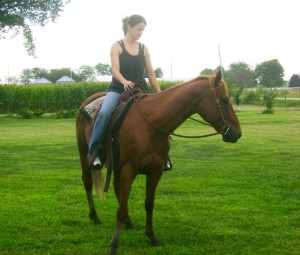
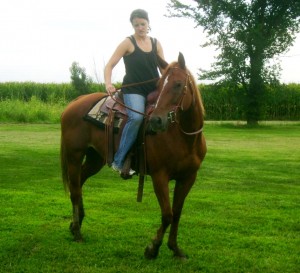
The whole method is best learned if the rider releases pressure immediately and completely at the first sign of the horse “giving” to the pressure. Timing is so important when you are teaching a horse something like this. When you release pressure at the correct action from the horse, you are saying to the horse, “There! That’s it, that’s what I’ve been wanting you to do!” And the horse thinks, “Oh, okay, that feels better, so I’ll do that again next time.” And that’s how you communicate.
We worked a bit on vertical flexion, too. Here is Daisy at the beginning of our ride:
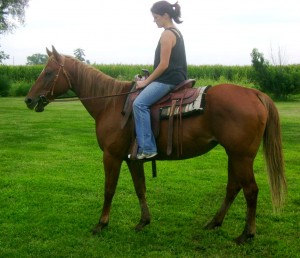
And here she is at the end. Notice the difference?
